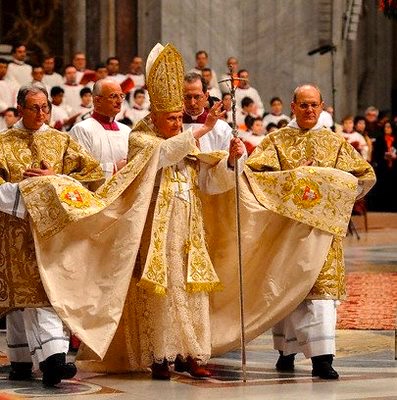by Hieromonk Petru Pruteanu
Lately, clerics and laymen (especially from the western parts of Romania, and not only) ask different question about the “baptism by pouring” practiced in some regions and that tends to become a used practice in almost all the local Orthodox Churches. There are on Internet also different confusing movies and pictures where the priests are performing a kind of inacceptable baptism, without even getting the baby undressed, not to mention about the parodies made in the case of baptizing an adult. Even worse than that is that “she’s funny that way” (the movie) and the cases of this type are even more than we can find on Internet, the reactions of hierarchs are almost lacking although I felt that some priests were afraid that the bishop might find that out though…
On the other side, one priest asked my help in the scandal he had with his churchly superiors. They accused the priest of “Protestantism” and of “transgressing the canons and tradition” when they heard about his intention to baptize a teenager in a river close by. That’s interesting, where did the Apostle Andrew baptize the first Dacians if not in the Danube or Black Sea? Isn’t it that the notion of “Apostolic Church” became just a name over time?
Thus, starting from the two premises, I will try to point out a few important ideas from a theological, historian-liturgical and canonic point of view. Of course, all of these can be extended and concretized through references but for the moment it is right to point out the followings:
- The word “baptism” (in Greek: βάπτισμα, from the verb βάπτω → βαπτίζω) has more meanings, but all are related to immerse somebody or something in a liquid followed by getting that somebody/thing out of it. The dictionaries give us the following meanings:
submergence/dive/immersion, dip or even drowning. Thus, for the biblical and patristic approach, the baptism without immersion is a nonsense, and the Apostles and Holy Fathers use this term and not προσχέω = to pour, λούω = a wash, βρέχω = to water, ραντίζω = to sprinkle sau καταστάζω = to drip. In order to simplify this matter, we are fully right if we translate the baptismal formula in the following way: “The servant of God, (N) is immersed, in the name of the Father, Amen. (Immerse) And of the Son, Amen. (Immerse) And of the Holy Spirit. Amen. (Immerse)
This literal translation does not allow any speculation since they would not be entitled in any way. And it becomes obvious that you cannot immerse in water without getting wet…
- About the spiritual sense of immersion in the baptism water St Apostle Paul writes in Romans 6:4, Colossians 2:12 and many Holy Fathers, as Cyril of Jerusalem, Gregory of Nyssa, Dionysius the Areopagite, John Damascene, Nicholas Cabasilla and others. All these texts talk about the complete immersion in the baptismal water as a symbol of death and rising, of the rebirth and of full cleaning. By performing the baptism only by pouring it means to ignore the symbol of death and rise and to only highlight the cleaning aspect of the Sacrament (according to Cyril of Jerusalem, “Mystagogical Catechesis II)
- The Forerunner John was baptizing in Aenon near Salim because there “was plenty of water” (according to John 3:23). Also Christ, after he was baptized by John in Jordan, “went up straightaway out of water” (Matthew 3:16). Likewise, also Philip baptized the Ethiopian in water and after he came out of it. (Acts 8:38-39). Thus, the Bible does not leave any room for doubts about the way of baptizing, and the other cases of baptism where the water is not mentioned (Acts 2:41; 9:18 and so on) most probably took place in the basins/fountains for ritual washing of Jews or in other parts where the immersion was possible. For instance, in the Zion regions were found tens of such type of basins even inside the house as well as Greek and Roman. Therefore, it is not surprising that all the ancient liturgical writings (“Didache”, “The order of Egyptian Church”, “The Apostolic Constitutions”, “Testamentum Domini” and so on) talk about the baptism by immersion in water, considering that the first churches were actually private houses made available for the community to perform the cult. In these basins as well as in the later baptisteries, the adults were coming in the water waist-deep or breast-deep and then after the priest and the bishop were laying their hand on their head, they were three times immersed in the water. The children and babies were completely immersed and got out of water for each immersion, especially when there were not special baptisteries for children and adults, as we see in Saint Sophia from Constantinople.
- The importance of the triple immersions in water is highlighted in the 50th Apostolic Canon that says: “If any Bishop or Priest does not perform three immersions (baptisms) in making one baptism, but only a single immersion (baptism) that given into the death of the Lord, let him be deposed. For the Lord did not say, Baptize into my death, but, “Go you and make disciples of all nations, baptizing them in the name of the Father, and of the Son, and of the Holy Spirit” (Matthew 28:19). The oldest extra biblical Christian writing is the “Didache of the twelve Apostles” (1st century) that also establishes the complete baptism as normative, through a triple immersion, allowing the pouring in case of insufficient water. Here is what the Didache says in Chapter 7: “And concerning baptism, baptize this way: Having first said all these things, baptize into the name of the Father, and of the Son, and of the Holy Spirit, in living water. But if you have no living water, baptize into other water; and if you cannot do so in cold water, do so in warm. But if you have neither, pour out water three times upon the head into the name of Father and Son and Holy Spirit.” Later, the Church accepted the “baptism through pouring” also for the cases when the candidate was laid down in bed and could not be immersed (according to Cyprian of Carthage in his “Letter to Magnus”). Yet, such type of baptism was acknowledged only through oikonomia and was not accepted as normative, likewise the case of Novatian mentioned by Eusebius of Caesarea in “The history of Church” (IV:43, 14-15). Therefore, both the Church of East and West accepted the baptism by pouring only for two cases: when there was not sufficient water (for instances, in wilderness and catacombs) and when the candidate could not be immersed due to a sickness. These were exceptions and they could not be accepted as rules!
- By way of proof, not only the Christians from East but also those from Italy and North Africa had baptisteries in all places. A big part of them are preserved also nowadays and they confess the complete baptism by immersion performed by the Christians from West as well during those times. Unfortunately, a much less or almost absent are the baptisteries for adults from Spain, Portugal, France, Great Britain or Germany and the baptismal fonts for babies made rarely possible their complete immersion in water. And thus, after the 7th century when the Church from West goes under the control of French-German or Spanish dynasties, some local traditions become normative for the entire West. The same holds true not only for the “baptism by pouring” but also for “Filioque” and other liturgical or dogmatic traditions, that did not appear in Rome, Milan or Carthage – the first big center of Latin Church – but in the far provinces of West.
- Although, at the beginning of the second millennium, the practice of “baptism by pouring” became dominant in the West, the big western theologians as Thomas Aquinas (13th century) and so on gave priority to the complete baptism, by immersion (although it is not clear whether a single or three immersions were performed). Later, the western theologians start to theologically reason the fact that βάπτισμα does not necessarily mean immersion, referring to the biblical texts like Mark 7:3-4 or Luke 11:38, not to mention the metaphorical expressions from Luke 12:50, Acts 1:4-5; 11:15-17. Likewise, there were often references to the baptism of sick ones and to a fresco from catacombs where the baptism was performed by pouring (although on a closer look a river can be spotted in the picture). Therefore neither the Italians used the baptisteries and thus the sprinkling, meaning the pouring became the only way of performing the baptism. Even the western icons of the Baptism of Lord started to show John pouring water on Christ using a jug, a thing that is almost comic. The 2nd Council from Vatican tried to come back to the baptism by immersion, but this is an extremely rare exception though for the Roman-Catholics.
- The problem of recognition of “baptism by pouring” performed by Roman-Catholics is a very complex one. The great Fathers of Church, as Photius of Constantinople (9th century), Theodore Balsamon (12th century) and Mark of Ephesus (14th century) considered that Latins did not need to be re-baptized but received through Chrismation as other “moderated heretics”. This position was confirmed by the Synod of Constantinople from 1484, imposed then to the Synod of Moscow from 1667. Later on, yet (probably rather from more political reasons than theological) another Synod of Constantinople from year 1755, decides the (re)baptism of Roman-Catholics, considering that the ancient Fathers only referred to the level of alienation of Latins from the Church and not to the way of baptism, not knowing that Latins, besides the obvious dogmatic heresies, renounced to the immersions of baptism that were always determining for Greeks especially due to the word βάπτισμα. A similar approach is pointed out within the 5th Canon of II Ecumenical Synod and 95th of Trulan as well, that acknowledge through oikonomia the baptism of Arians and other heretics. Of course, the Roman-Catholics are not more wandered than Arians, but their baptism was acknowledged first of all because of the three immersions and scarcely on the second place due to invoking the Three Persons, even if they considered the Holy Father as being the “Absolute God”. At the same time, the same canons involve the re-baptism of Eunomians because they had only one immersion – a form that pointed out a disclaimer for the Trinity. The neo-protestants of nowadays have also a single immersion, without having any connection with the Eunomians, but as an old western practice that according to the local heresies taken into account, they felt they had to highlight more the unity of Trinity rather then the difference between Its Persons.
- The way to reconcile the two parallel worlds, where “everyone is right in their own eyes” is very complex. (…) We have apostolic rules though that point out the safest way to do it and according to these, there is no reason to automatically acknowledge the “baptism by pouring” and to apply it on a large scale, even if we have sufficient water or/and the candidate does not have the expressed interdiction of doctors to be immersed in water. (And if we want to make the exceptions as rules, then we should renounce to canonicals and replace the epitrachelion with a scarf or a belt because this thing is also allowed on exceptional cases). The “baptism by pouring” is and it has to stay an exception, and for the ordinary cases, we have to insist on the right form of baptism, by the complete triple immersions, as the 50th Apostolic Canon and the entire Tradition of Church says (see also G. Metallinos “I confess one Baptism”)
- Due to a western influence, especially in the zones that were occupied for a longer time by Roman-Catholics (Transylvania, Banat, West of Ukraine, etc.), a lot of orthodox priests perform the “baptism” only by pouring/sprinkling without having no serious reason for that. Moreover, many churches do not even have baptismal fonts and if they do have them, they do not even use them. Entire generations of orthodox from the majority of “orthodox churches” are wrongly “baptized”. Through the contact with the Greek Church and Mount Athos, where the baptism by immersion is respected with a lot of acrivia, a lot of Romanian, Russian, Ukrainian, Serbian and Bulgarian orthodox people started to doubt the validity of their baptism. This doubt is somehow right, noticing the indifference and offhandedness that the canons and Orthodox Tradition are transgressed with. Moreover, the priests do not make any effort to explain the believers the way the baptism has to be performed, but they accept without any problem the request of parents to not immerse the child. The parents, if they really want to baptize their child, will have to accept the practice of the Church and live according to Its teaching and if they insist on a formal act just for the sake of a custom or for a more successful photo session, the priest will have to have the courage to tell them that they “came to the wrong office”. By doing this, the Church will not lose any of its real sons (as some priests, who think they are very responsible are afraid of) but they will easier draw far those who try to sneak in Its bosom as some “thieves and robbers” that do not “enter by the door” but “climb up some other way”. There are also some people who do not know the correct way, but if you explain them that the correct baptism is performed by a triple immersion and they do not accept this, how will then they accept the entire way of life that the Church asks from the baptized ones? Or some priests should admit that they are not interested in the salvation of those whom they sprinkle on their heads, but only take their money…
- In order to solve the already existing problems and correcting the further situation, I consider that every Local Church respectively or maybe all together (on a pan-orthodox level) should take some synodic clear decisions for solving this disturbing, doubting and disordered situation. And because most of the questions related to this subject came from clerics and laymen from the Romanian Orthodox Church, I dare and I take the risk to propose a project of a Synodic decision that Romanian hierarchs and theologians could improve, enact and apply. This is the way I imagine the text of this Project of Synodic decision:
***
- All the sons of Romanian Orthodox Church over time and hitherto who were not baptized by the three immersion mentioned by the 50th Apostolic Canon, but by partial immersion or pouring/sprinkling, through the oikonomia of grace that God gave to the Church and through this synodic decision, their baptism is acknowledged as valid and we decide that from now on the problem of validity for their baptism or rebaptism must not be questioned anymore.
- The baptism by pouring/sprinkling was generalized in some areas of Romania through heterodox influences and this practice must not be tolerated from now on. At present all the parishes of Orthodox Romanian Church can freely manifest their liturgical and missionary activity and they must take care to have baptismal fonts and to correctly perform the baptism by the triple immersion. The baptism by pouring cannot be accepted even if it is insistently asked by the parents and especially in this situation the pre-baptismal catechesis must be intensified.
- The bishops must take care that within the eparchy exist at least 2-3 baptisteries for baptizing the adults and they must be baptized only there by the parson of the candidate (that also took care of his catechesis) with the permission of parson/ecclesiarch where the baptistery is. Till the construction of baptisteries or in other special cases, the baptism can be made in rivers, lakes or in the sea if there it is clean water and conditions for performing the service in decent conditions.
- According to the Tradition of Church, the baptism by pouring is accepted only if there is not sufficient water or the candidate is seriously ill and his immersion is not allowed. If there are no medical contraindications for wetting the sick catechumen and his immersion is hindered only by his impossibility to move then wetting the body with holy water will be performed as generous as possible in a cross shape: from head to toes then from the right shoulder to the left so that all the body and all senses are sanctified.
- In all cases, the new-baptized ones must take the Holy Communion in the same day, then more often during their entire life. For giving communion to the new-baptized babies it is recommended that the baptism is performed together with the Liturgy or immediately after, before consuming the Holy Communion so that the babies can get at least one drop of the Holy Blood.
- The bishops must very strictly supervise the enacting of this decision and they have to be themselves an example in right performance of the baptism. The servants who from now on transgress the present decision will be deposed according to the 50th Apostolic Canon.






